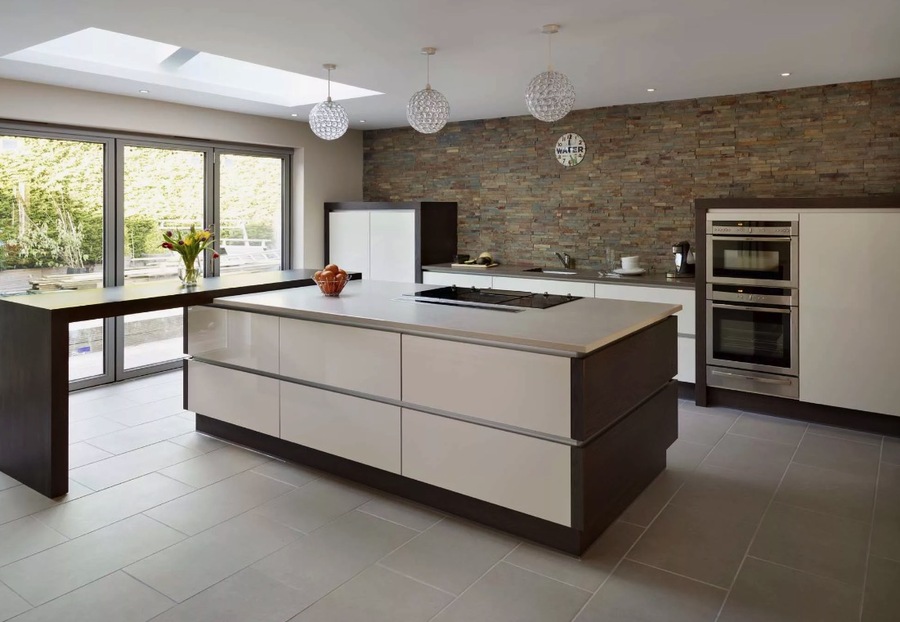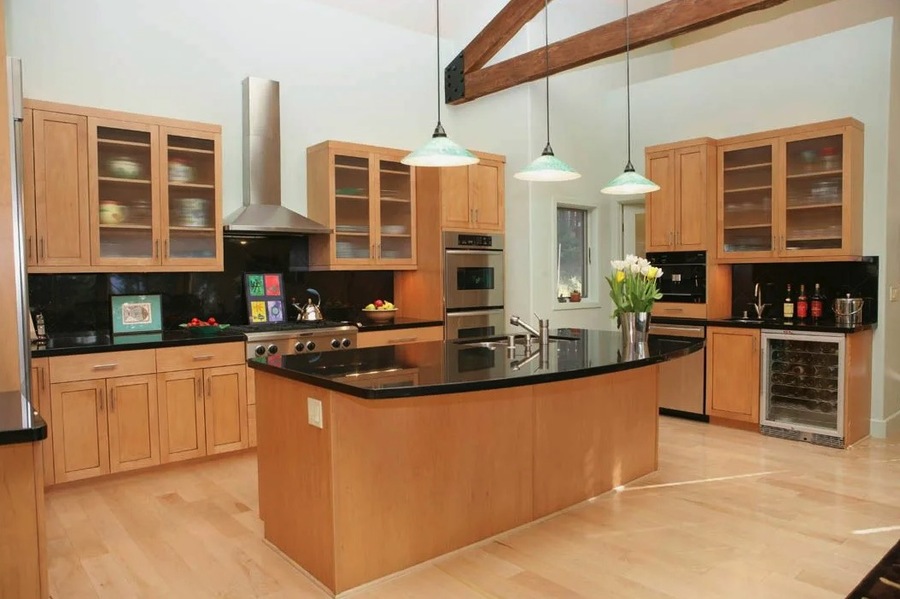The kitchen has always been a central part of the home, evolving significantly from its early days. Initially, it was a simple place for cooking over an open fire. Over the centuries, as cooking techniques and social dynamics changed, so did the design and functionality of the kitchen. Today, especially with the trend of interior fit out Dubai, kitchens are designed not only for practicality but also to reflect style and sophistication, becoming a focal point in modern homes.
Historical Development of the Kitchen
The kitchen has always been a central part of the home, evolving significantly from its early days. Initially, it was a simple place for cooking over an open fire. Over the centuries, as cooking techniques and social dynamics changed, so did the design and functionality of the kitchen.
Ancient Times
Egypt, Greece, and Rome: In ancient civilizations, the kitchen was often located in a separate building or an open courtyard to manage the smoke and fire hazards. The Greeks and Romans, known for their culinary advancements, developed early forms of stoves and ovens. In Rome, for instance, communal kitchens were prevalent, serving large households and gatherings. The Roman “culina” was equipped with hearths and braziers, and the more affluent homes had complex systems for baking bread and cooking elaborate meals.
Middle Ages
In medieval Europe, the kitchen remained rudimentary and often dark, smoky, and isolated. Kitchens were typically located in the basements or separate buildings away from the living quarters to minimize fire risks and smoke infiltration. The hearth was the central element, and cooking was labor-intensive. Wealthy households had large kitchens with multiple fireplaces for different cooking tasks, while peasants used simpler setups, often sharing communal facilities in villages.
Renaissance and Enlightenment
The Renaissance period brought a renewed interest in architecture and domestic life, leading to the integration of kitchens into the main house structure. Chimneys became a common feature, improving ventilation and making indoor kitchens more viable. This era saw the introduction of more sophisticated cooking tools and utensils. The layout started to reflect a more organized approach to food preparation, with dedicated spaces for different tasks.
19th Century
The Industrial Revolution marked a significant shift in kitchen design and technology. The development of cast iron stoves replaced open hearths, making cooking more efficient and safer. Gas and later electric stoves were introduced, further revolutionizing kitchen design. The concept of the “work triangle,” which optimizes the workflow between the sink, stove, and refrigerator, began to take shape. Middle-class homes started to feature more organized and functional kitchens.
20th Century
The early 20th century saw the kitchen transform into a more functional and aesthetically pleasing space. The introduction of electricity brought new appliances like refrigerators, blenders, and microwaves, making cooking easier and more convenient. The 1920s and 30s introduced the idea of the “fitted kitchen,” where cabinets and countertops were built-in, creating a seamless and efficient workspace. Post-World War II saw a boom in kitchen innovation, with a focus on modern appliances and ergonomic design.
Modern Times
Today, kitchens are the heart of the home, serving as a place for cooking, socializing, and family gatherings. Open-plan designs integrate the kitchen with living and dining areas, promoting interaction and versatility. Technological advancements have introduced smart appliances that can be controlled via smartphones, enhancing convenience and efficiency. Contemporary kitchens are designed with both functionality and style in mind, featuring high-end finishes, sustainable materials, and innovative storage solutions.

Types of Kitchens
Kitchens vary in design and layout, catering to different needs and preferences:
Single-Wall Kitchen
– All appliances and cabinets are located on a single wall, ideal for small spaces. This layout maximizes space efficiency and is often found in studio apartments or smaller homes. It allows for easy access to all kitchen components but may limit the amount of workspace and storage.
Galley Kitchen
Consists of two parallel walls with a walkway in between, maximizing efficiency in narrow spaces. This design is favored by professional chefs due to its streamlined workflow. Everything is within reach, making it easy to move between tasks. However, it can feel cramped if not properly planned, and it’s less suited for socializing.
L-Shaped Kitchen
Cabinets and appliances are arranged along two adjacent walls, creating an efficient work triangle. This layout is versatile and fits well in open-plan homes. It provides ample counter space and allows for a more open feel, often incorporating a dining area or breakfast nook. It’s ideal for medium to large kitchens.
U-Shaped Kitchen
Features three walls of cabinets and appliances, providing ample counter space and storage. This layout is great for larger kitchens, offering plenty of room for multiple cooks. It maximizes efficiency by keeping everything within reach while also providing abundant storage. The design creates a more enclosed feel, which can be both cozy and practical.
Island Kitchen
Incorporates an island in the center, offering additional counter space and storage, often used for food preparation or dining. The island can house a sink, cooktop, or seating area, making it a multifunctional feature. This layout promotes social interaction, as it often becomes a focal point for gatherings. It requires a larger space to accommodate the island without feeling cramped.
Peninsula Kitchen
Similar to an island kitchen but connected to the main workspace, offering extra counter space and an eating area. The peninsula can help define the kitchen space in an open-plan home, providing a clear boundary while maintaining an open feel. It’s a great solution for smaller spaces that can’t accommodate a full island.
Interior Items in the Kitchen
A well-equipped kitchen includes various interior items essential for cooking and dining:
Cabinetry
Provides storage for utensils, cookware, and food. Materials range from wood to laminate, with styles from traditional to modern. Custom cabinetry can be tailored to fit specific needs, incorporating features like pull-out shelves, lazy Susans, and built-in spice racks. High-quality cabinets are durable and add to the kitchen’s aesthetic appeal.
Countertops
Work surfaces made from materials like granite, quartz, marble, or laminate, chosen for durability and aesthetics. Granite and quartz are popular for their durability and resistance to stains and scratches, while marble offers a luxurious look but requires more maintenance. Laminate is a budget-friendly option available in a variety of designs.
Sink
An essential component, available in various materials such as stainless steel, porcelain, or composite. Double-bowl sinks offer versatility for washing and rinsing, while farmhouse sinks provide a deep basin for large pots and pans. The choice of faucet can also enhance functionality, with options like pull-down sprayers and touchless models.
Lighting
Includes overhead lights, task lighting under cabinets, and ambient lighting to create a welcoming atmosphere. Proper lighting is crucial for both functionality and ambiance. Pendant lights over islands, under-cabinet LED strips, and recessed ceiling lights are common choices that ensure the workspace is well-lit and inviting.
Backsplash
Protects walls from spills and splatters, available in materials like tile, glass, or stainless steel. Backsplashes can add a decorative element to the kitchen, with options ranging from simple subway tiles to intricate mosaics. They are easy to clean and maintain, providing both functionality and style.
Flooring
Should be durable and easy to clean, with options like tile, hardwood, laminate, or vinyl. Porcelain tile is highly durable and water-resistant, while hardwood offers a warm, timeless look but requires more care. Vinyl and laminate are budget-friendly and come in a variety of styles, including those that mimic wood and stone.
Furniture
Includes dining tables, chairs, and bar stools, often chosen to match the kitchen’s style. In open-plan kitchens, the choice of furniture can help define different areas. Comfortable seating and a well-placed dining table make the kitchen a welcoming space for meals and gatherings.

Kitchen Appliances
Modern kitchens are equipped with various appliances that enhance cooking efficiency and convenience:
Refrigerators
Essential for food storage. Leading manufacturers include Samsung, LG, and Whirlpool. Modern refrigerators come with features like adjustable shelving, water and ice dispensers, and smart technology that allows remote control and monitoring via smartphone apps.
Ovens and Stoves
Available in gas, electric, and induction models. Popular brands are GE, Bosch, and Miele. Gas stoves provide precise temperature control, while electric and induction models offer even cooking and sleek designs. Dual-fuel ranges combine the best of both worlds, with a gas cooktop and an electric oven.
Microwaves
For quick heating and cooking. Panasonic and Sharp are well-known manufacturers. Over-the-range microwaves save counter space and often include built-in ventilation systems. Convection microwaves offer additional cooking options, acting as a secondary oven.
Dishwashers
Save time and water compared to handwashing. Brands like Bosch, KitchenAid, and Siemens are highly rated. Modern dishwashers are energy-efficient and come with features like adjustable racks, multiple wash cycles, and quiet operation. Some models even include smart connectivity for remote operation.
Small Appliances
Include blenders, toasters, and coffee makers from brands like Breville, Cuisinart, and Nespresso. High-quality small appliances can enhance daily kitchen tasks, offering convenience and efficiency. Specialty appliances like stand mixers and air fryers have also become popular, catering to specific cooking needs.
Zoning in the Kitchen
Effective kitchen design involves dividing the space into zones for different activities:
Preparation Zone
Includes countertops, cutting boards, and small appliances like mixers and food processors. This zone should have ample counter space and easy access to utensils and ingredients. Proper lighting and a nearby sink for washing produce and hands are also important.
Cooking Zone
Houses the stove, oven, microwave, and nearby utensils. This area should be well-ventilated and provide easy access to pots, pans, and cooking tools. A backsplash behind the stove protects the wall from spills and splatters.
Cleaning Zone
Centered around the sink and dishwasher, with nearby storage for cleaning supplies. This zone should have a durable countertop surface and ample space for drying dishes. Under-sink storage can house cleaning products and waste bins.
Storage Zone
Includes cabinets, pantry, and refrigerator for food and cookware storage. Efficient storage solutions like pull-out shelves, lazy Susans, and deep drawers maximize space and keep the kitchen organized. The refrigerator should be easily accessible from the cooking and preparation zones.
Dining Zone
Features a dining table or breakfast bar for eating and socializing. This area should be comfortable and inviting, with proper lighting and seating. In open-plan kitchens, the dining zone often serves as a transition between the kitchen and living areas.
Software Tools for Kitchen Planning
Several software tools help homeowners and designers plan and visualize kitchen layouts:
SketchUp
A 3D modeling tool that allows detailed kitchen design and customization. SketchUp is user-friendly and offers a vast library of components, making it easy to experiment with different layouts, materials, and styles.
Home Designer Suite
Offers comprehensive design tools for creating floor plans and interior layouts. This software includes features like 3D visualization, cost estimation, and a wide range of customization options. It’s suitable for both professionals and DIY enthusiasts.
IKEA Kitchen Planner
Free tool for designing kitchens using IKEA products, with a focus on functionality and space optimization. This planner allows users to create detailed kitchen layouts, select products, and visualize the final design. It’s ideal for those who prefer IKEA’s modular approach.
Houzz
Provides design ideas and visualization tools to plan and furnish a kitchen. Houzz features a vast collection of photos, articles, and product recommendations. Users can create idea boards, explore different styles, and even connect with professionals for advice and services.
Roomstyler 3D Home Planner
User-friendly software for creating 3D kitchen layouts and experimenting with different styles and configurations. Roomstyler offers a drag-and-drop interface, making it easy to design and visualize a kitchen. It includes a wide range of furnishings and finishes to choose from.
Fashionable Kitchen Styles in Dubai
Dubai is known for its luxurious and modern interiors. Popular kitchen styles include:
Contemporary
Sleek lines, minimalistic design, and high-tech appliances. Contemporary kitchens often feature handle-less cabinets, integrated appliances, and a neutral color palette. High-gloss finishes and innovative materials like stainless steel and glass are common.
Modern
Emphasizes clean lines, open spaces, and a neutral color palette. Modern kitchens prioritize functionality and simplicity, with an emphasis on open-plan layouts and natural light. Matte finishes and monochromatic schemes are popular, often accented with bold colors.
Traditional
Rich wood cabinetry, ornate details, and classic appliances. Traditional kitchens evoke a sense of warmth and elegance, with intricate moldings, decorative hardware, and natural materials. They often include features like a farmhouse sink and a central island with a butcher block top.
Transitional
Combines modern and traditional elements for a balanced look. Transitional kitchens blend contemporary and classic styles, offering flexibility in design. They might feature shaker-style cabinets with modern hardware, or a mix of natural and synthetic materials.
Industrial
Features raw materials like exposed brick, metal fixtures, and open shelving. Industrial kitchens have a rugged, utilitarian feel, often incorporating elements like concrete countertops, reclaimed wood, and vintage appliances. Open shelving and visible ductwork add to the aesthetic.
Mediterranean
Warm colors, rustic textures, and natural materials. Mediterranean kitchens are inspired by the coastal regions of Spain, Italy, and Greece. They often feature terracotta tiles, wrought iron accents, and vibrant colors like cobalt blue and sunflower yellow. Arched doorways and mosaic backsplashes are common design elements.

Acceptable Materials for Kitchen Renovation in Dubai
Granite and Quartz
Popular for countertops due to their durability and aesthetic appeal. Granite offers a unique, natural look with various patterns and colors, while quartz provides a more uniform appearance and is non-porous, making it easy to maintain.
Stainless Steel
Used for appliances and countertops, offering a sleek, modern look. Stainless steel is durable, heat-resistant, and easy to clean, making it ideal for high-use areas. It complements both contemporary and industrial kitchen styles.
Porcelain Tiles
Ideal for flooring and backsplashes, known for their durability and variety of designs. Porcelain tiles are water-resistant and come in numerous styles, including those that mimic natural stone or wood. They are a practical and stylish choice for kitchen surfaces.
Solid Wood
Used for cabinetry, providing a classic and timeless appearance. Wood cabinets can be stained or painted to match any design aesthetic. High-quality woods like oak, maple, and cherry are durable and add warmth to the kitchen.
Glass
Used in backsplashes and cabinet doors to create a contemporary feel. Glass adds a reflective quality that can make small kitchens appear larger. It’s also easy to clean and available in various textures and colors.
The Role of the Kitchen in Modern Life
The kitchen has become more than just a place for cooking; it’s a central hub for family life, socializing, and entertaining. It reflects personal style and values, promoting healthy eating, sustainability, and innovation in culinary practices. With advancements in technology and design, kitchens continue to evolve, adapting to the changing needs and lifestyles of modern society. In many homes, the kitchen serves as a multifunctional space where people gather, work, and create lasting memories. The integration of smart technology, such as voice-activated assistants and connected appliances, has further enhanced the kitchen’s role, making it a hub of convenience and efficiency. The modern kitchen is a place where culinary creativity meets social interaction, embodying the heart and soul of the home.

Basketball fan, risk-taker, guitarist, Vignelli fan and fullstack designer. Doing at the crossroads of design and function to craft delightful brand experiences. Let’s make every day A RAZZLE-DAZZLE MUSICAL.
